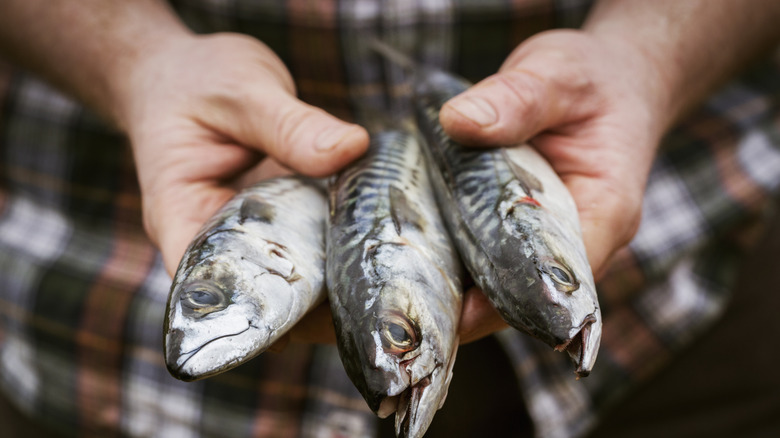An Underrated Fish High In Magnesium Also Has More Omega-3s Than Walnuts (But There's A Catch)
In a perfect world, you'd be able to achieve the recommended daily dose of every key nutrient your body needs. But that's not always possible, which is why you may have to decide which are most important to you, possibly based on age-related nutritional requirements or another factor. For instance, if you're hoping to lower your risk of cardiovascular disease, better control your blood sugar, and potentially improve your sleep quality, you may want to focus on consistently getting enough magnesium.
But what if you're also interested in reducing your chances of breast, colorectal, and prostate cancers, not to mention protecting against degenerative brain conditions? You may want to include omega-3 fatty acids on your list of nutritional must-haves. After all, most people could use some extra omega-3s, as observed by professor Ann Skulas-Ray when she told the American Heart Association that intakes of omega-3s in the United States "are abysmally low."
Fortunately, you don't always have to eat separate foods to get magnesium and omega-3s. Some foods, such as mackerel, are abundant in both nutrients.
A fish filled with heart-friendly and system-supportive fats
With mackerel, you get 60 milligrams of magnesium for every 100 grams you eat, making it possible to inch closer to the 310 to 450 milligrams of magnesium per day that's suggested for adults. In the process, you also get omega-3s: Every 100-gram serving of mackerel contains 2.96 grams of docosahexaenoic acid (DHA) and 1.62 grams of eicosapentaenoic acid (EPA), which are types of polyunsaturated fats that fall under the category of omega-3s.
Of course, you may have heard that walnuts are a great source of omega-3s, which is accurate but doesn't tell the whole story. In return for munching on 100 grams of walnuts, you'll receive 9.08 grams of alpha-linolenic acid (ALA), which is a third type of essential omega-3. However, you won't get any DHA or EPA directly from walnuts. (A small percentage of ALA can be turned into DHA and EPA, but it's not substantial.) In other words, you need a different source for DHA and EPA, which is where a fatty fish like mackerel can be a wellness win.
Science-supported upsides despite a caveat
Science helps show how vital DHA and EPA can be to your current and future health. A 2023 review in Current Opinion in Lipidology noted that taking 3.36 grams of combined DHA and EPA daily could delay the chance of dementia by 2.5 years in individuals over age 55 who also had heart disease. Magnesium may have neuroprotective properties as well. A 2022 review in the International Journal of Molecular Sciences showed that magnesium seemed to reduce brain inflammation, which tends to accompany degenerative neurological disorders.
Science also supports the use of omega-3s for heart health. Findings from a 2022 analysis in JAHA indicated that taking 2 to 3 grams of combined DHA and EPA daily could bring down elevated blood pressure levels. Interestingly, a 2011 study in the Journal of Clinical Hypertension concluded that consuming between 500 and 1,000 milligrams of magnesium each day could help reduce blood pressure without medication as well.
Still love snacking on walnuts? Keep eating them, but consider adding mackerel into your diet to leverage the attributes of magnesium and omega-3s. However, be careful when you choose your mackerel, as some species contain unhealthy levels of mercury. For example, king mackerel has some of the highest concentrations of mercury, according to the U.S. Food and Drug Administration (FDA). On the other hand, North Atlantic mackerel and chub mackerel offer relatively low levels of mercury, reducing your risk of exposure to toxic mercury levels.


